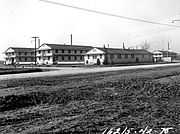Camp Forrest
Camp Forrest, located in Tullahoma, Tennessee, was one of the U.S. Army's largest training bases during World War II. It was an active army post between 1941 and 1946.
History
The camp, named after Civil War cavalry Confederate General Nathan Bedford Forrest, was originally named Camp Peay. Camp Peay was named after the Tennessee Governor Austin Peay and built in Tullahoma as a National Guard Camp in 1926. Camp Peay covered 1,040 acres (4.2 km²). Camp Forrest covered 85,000 acres (340 km²) located just beyond the old Camp Peay.
The camp was a training area for infantry, artillery, engineer, signal organizations, and cooks. It also served as a hospital center and temporary encampment area for troops during maneuvers. Major General George Patton brought his 2nd Armored Division from Fort Benning, Georgia for maneuvers.
William Northern Field, an air training base, was an addition used as a training site for crews of four-engined B-24 bombers of the Army Air Forces.
Incoming troops had the normal amenities such as service clubs, guest houses, library, post exchanges, post office, hospital, religious services, theaters, showers, Red Cross, and Army Emergency Relief facilities. Recreation facilities include swimming, archery, tennis, a sports arena and a nine-hole golf course.
Camp Forrest officially became a prisoner of war camp May 12, 1942. The camp housed Italian and German POWs. Prisoners became laborers at Camp Forrest in the hospitals and on farms in the local community. Initially the camp held civilian detainees who were arrested at the outbreak of the war under a program called "Alien Enemy Control." Many of these internees were incarcerated without legal process. Official government documents made available in the late 1990s indicate that over 25,000 Alien Enemies were held at various locations throughout the United States. Camp Forrest's population was over 700. German internees at Camp Forrest published a newsletter titled The Latrine.[1] In 1943 Camp Forrest internees were transferred to other Internment Camps to make room for actual POWs captured on the field of battle.
In 1945 the U.S. government implemented an Intellectual Diversion Program to educate Germans on the American way of life. This program used educational and recreational media to change views of POWs, and the government claimed success with many prisoners.
Tullahoma was greatly affected by the installation of Camp Forrest. Because of maneuvers and operations, civilians had to adjust to blocked roads, traffic jams, crowded stores, the absence of mail delivery and driving at night without lights. Soldiers camped out on lawns and fields; many crops and fences were destroyed.
In 1940 the population in Tullahoma was 4,500. By the end of the war, the population had grown to 75,000. Many military people who moved in for construction and operation of the camp remained after the war.
In 1946 the war was over and Camp Forrest and Northern Field were declared surplus property. Buildings were sold at auction, torn down and carted away. Water and sewage systems and electrical systems were sold as salvage. All that remained were roads, brick chimneys and concrete foundations.
Soon after the close of the camp, the area was selected for the site of the air force's new Air Engineering Development Center. In 1951 the center was dedicated by President Truman and renamed the Arnold Engineering Development Center in honor of General of the Air Force Henry H. "Hap" Arnold. General Arnold was World War II Commander of the Army Air Corps and the only air force officer to hold 5-star rank.
See also
References
- ↑ "Camp Forrest Internee Newspaper: The Latrine". The Freedom of Information Times. Retrieved 2014-02-06.
- Camp Forrest. Arnold Engineering Development Center, Arnold Air Force Base, TN
-
 This article incorporates public domain material from the United States Government document "Camp Forrest. Arnold Engineering Development Center, Arnold Air Force Base, TN".
This article incorporates public domain material from the United States Government document "Camp Forrest. Arnold Engineering Development Center, Arnold Air Force Base, TN".



